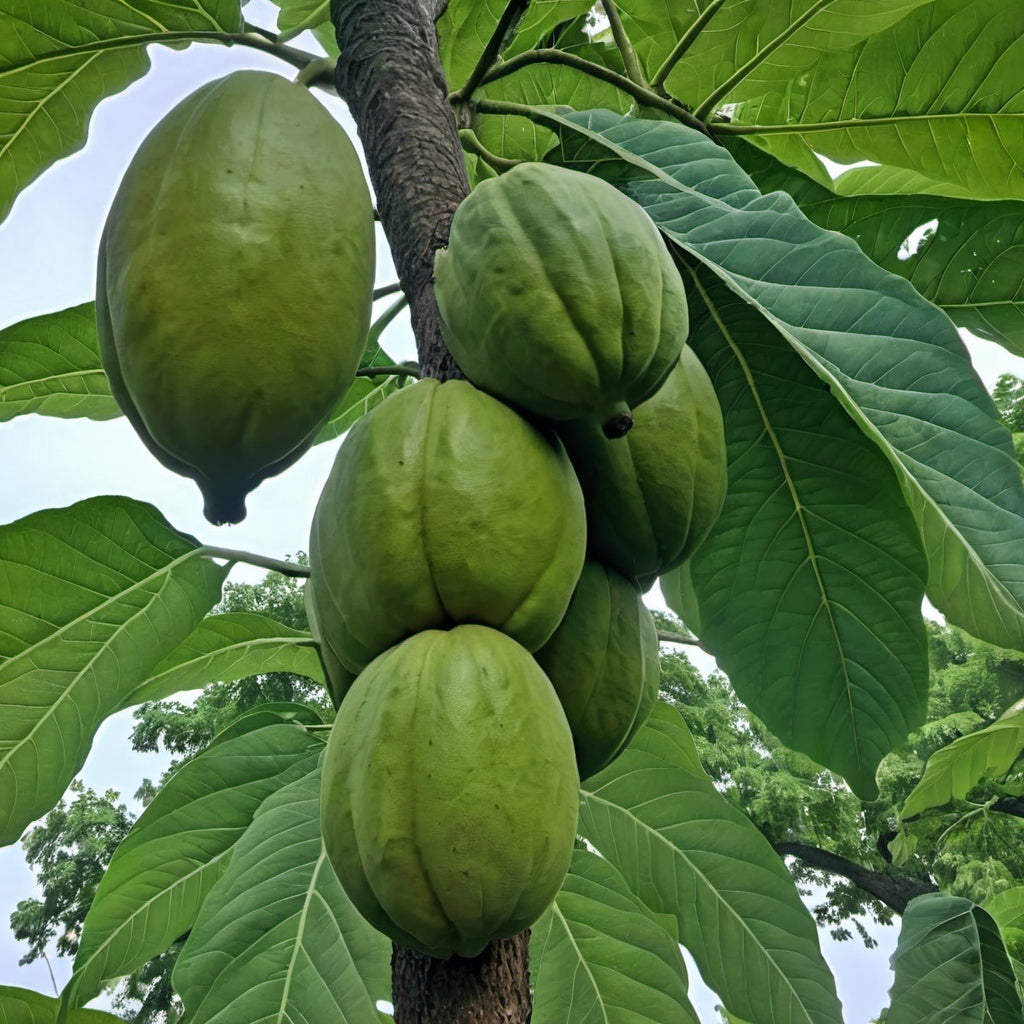Common PawPaw Tree Seeds
Common PawPaw Tree Seeds
Couldn't load pickup availability
Common PawPaw Tree Seeds
(Asimina triloba)
Asimina triloba, commonly known as the Common PawPaw, is a small deciduous tree native to the eastern United States and Canada. It belongs to the Annonaceae family, the same family as tropical fruits like soursop and cherimoya, making it unusual for a temperate region plant.
Key Features:
Appearance: Pawpaw trees typically grow 15–30 feet (4.5–9 meters) tall. They have large, simple, dark green leaves that can be up to 12 inches long, providing a tropical look.
Flowers: The tree produces distinctive maroon flowers in spring before the leaves emerge. These flowers have six petals and emit a faint, yeasty odor that attracts pollinators like flies and beetles.
Fruit: The pawpaw fruit is its most notable feature. It is a greenish-yellow, oblong fruit about 3–6 inches long, resembling a small mango. Inside, the flesh is creamy and custard-like, with a flavor often described as a blend of banana, mango, and melon. The seeds are large and brown, arranged in two rows within the fruit. The fruit ripens in late summer to early fall.
Habitat and Growth:
Native Range: Pawpaw trees are found in river valleys, floodplains, and forests across much of the eastern U.S., from the Great Lakes down to the Gulf Coast. They prefer rich, well-drained soils and grow well in both full sun and partial shade.
Cultivation: Though often grown in the wild, pawpaws have gained popularity in permaculture and edible landscaping due to their unique fruit. They require cross-pollination between different genetic plants to bear fruit, making it essential to plant at least two pawpaw trees near each other.
Ecological Importance:
Wildlife: Pawpaw fruit is a food source for various animals, including raccoons, squirrels, opossums, and birds. However, the leaves, bark, and seeds contain a chemical compound called annonacin, which makes them unpalatable or toxic to most herbivores.
Pollinators: The flowers attract specific pollinators, such as flies and beetles, which are less common than the bees and butterflies that pollinate other fruit trees.
Uses:
Culinary: Pawpaw fruit can be eaten raw or used in recipes like custards, smoothies, ice cream, or bread. It’s highly nutritious, rich in vitamins A and C, magnesium, and antioxidants.
Traditional Medicine: Native American tribes historically used pawpaw in folk medicine for various ailments. The seeds, leaves, and bark have also been studied for their potential medicinal properties, particularly for their anti-cancer compounds.
Other Uses: Pawpaw bark has been used to make fibers for fishing nets, ropes, and mats by indigenous peoples.
The tree's growing popularity as a backyard fruit is due to its unique, exotic flavor and ability to grow in non-tropical climates.
Zones: 5 to 8
Stratification Requirement: Seed requires 90-120 days cold moist stratification. We are told Temperature in sowing is very important. 90-95 deg F germinates in 1-2 weeks or less. 80-85 deg. F germ in 2-4 weeks; less than 75 Deg. F- many months or never. seeds laying on the ground over the winter - even down to -20 F - as long as given very warm, very moist conditions. cold soil stop seed from germinating.
Planting Instructions:
Pawpaw seeds must go through a period of cold moist stratification to break dormancy, as they naturally germinate in the spring after winter. This can be achieved by placing the cleaned seeds in a sealed plastic bag with slightly moist peat moss or sand and refrigerating them for 90 to 120 days at temperatures between 32°F and 40°F (0°C to 4°C). Be sure to check the moisture level occasionally to prevent the seeds from drying out or becoming too soggy.
After the stratification period, it's time to plant the seeds. Choose a well-draining potting mix or a garden bed with rich, loamy soil. Plant the seeds about one inch deep, ensuring the pointed end faces down. Pawpaw seeds can be slow to germinate, often taking several weeks. Maintain consistent moisture, but avoid waterlogging the soil. Pawpaw seedlings are sensitive to strong sunlight in their early stages, so it’s best to grow them in partial shade or under a shade cloth. Once the seedlings have developed sturdy roots and grown to about 6 to 12 inches tall, they can be transplanted to their permanent location. Keep in mind that pawpaw trees prefer a spot with full sun as they mature and thrive in well-drained, slightly acidic soils.
Additionally, it’s important to be aware that pawpaw trees are typically not self-pollinating, so planting at least two genetically distinct trees within close proximity will help ensure successful fruit production. Patience is key, as pawpaw trees take several years to reach maturity and produce fruit, but the reward of their unique, custard-like fruit is well worth the wait.
Share


